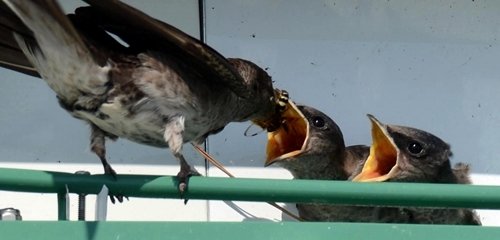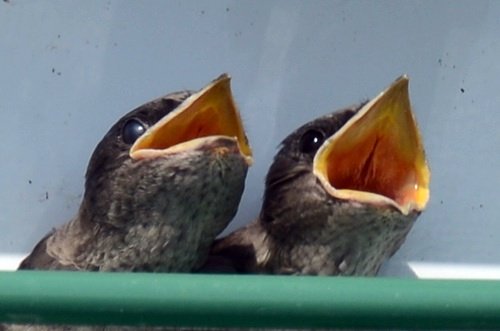A pair of scouts show up every year on Feb 15, plus or minus a couple days.
Usually fully mature males (dark purple,completing their second migration) but sometimes includes 2nd year males (white breasts,completing their first- horny like teenagers)
By early May all of our 20 nest cavities are fully occupied- this year 96 young purple martins were hatched. Both parents feed the young - mostly large insects like wasps. It is a myth that martins eat lots of mosquitos- they fly higher and leave that small stuff to the swallows that also live on our dock.
By the first week of July the young martins come out of the nest to be fed and will soon fledge. By mid July they'll be gathering in a roost elsewhere prepping for their migration to Brazil where they spend 1/2 the year but do not breed. Many of these youngsters will not survive their first migration but those which do will be back next year, like clockwork, to produce the next generation.
In the east, martins breed almost exclisively in human-provided housing, having learned it is by far the safest protection from predators. They prefer to nest in open spots about 50-100 ft from a house and tolerate human activity right under nests as well as regular nest inspections. Native Americans were already providing nesting gourds when Europeans first came to America.
Photos are downsized crops using a Nikon D800E with an 80-400mm Nikon zoom
Usually fully mature males (dark purple,completing their second migration) but sometimes includes 2nd year males (white breasts,completing their first- horny like teenagers)
By early May all of our 20 nest cavities are fully occupied- this year 96 young purple martins were hatched. Both parents feed the young - mostly large insects like wasps. It is a myth that martins eat lots of mosquitos- they fly higher and leave that small stuff to the swallows that also live on our dock.
By the first week of July the young martins come out of the nest to be fed and will soon fledge. By mid July they'll be gathering in a roost elsewhere prepping for their migration to Brazil where they spend 1/2 the year but do not breed. Many of these youngsters will not survive their first migration but those which do will be back next year, like clockwork, to produce the next generation.
In the east, martins breed almost exclisively in human-provided housing, having learned it is by far the safest protection from predators. They prefer to nest in open spots about 50-100 ft from a house and tolerate human activity right under nests as well as regular nest inspections. Native Americans were already providing nesting gourds when Europeans first came to America.
Photos are downsized crops using a Nikon D800E with an 80-400mm Nikon zoom



